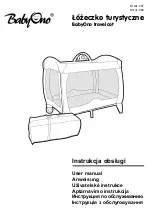
#4 -13511 Crestwood Place, Richmond, BC, V6V 2E9, Canada
+ 1.778.776.3288
discoverbattery.com
3.6 Ripple Currents
•
During recharging (up to 2.40VPC) the effective value of the
AC ripple current may temporarily reach a maximum 10A per
100Ah of C
10
nominal capacity.
•
After recharging and at float charge in stand-by operation or
buffer operation the effective value of the AC ripple current
must not exceed 5A per 100 Ah of C
10
nominal capacity.
4. Battery Maintenance
4.1 Visual Inspection and Cleaning Instructions
Check for any visible defects such as cracked jars, loose terminal
posts and oxidized connectors. To avoid leakage currents and the
asSoCiated risk of fire, keep the battery dry and clean. Clean with
clear water. Do not use any solvents or detergents. Avoid electrostatic
charges.
4.2 Bi-annual Maintenance
•
Battery voltage
•
Voltage of some cells/bloc batteries (pilot cells)
•
Temperature of the container in some cells/bloc batteries (pilot
cells)
•
Confirm daily DoD per cell
•
Confirm max DoD per cell does not exceed the allowed limit
•
Confirm charging factor is within acceptable limits
•
Confirm that charge settings correspond to recommendations
•
Check if corrective equalizing is applied according to 3.2.2.2
4.3 Annual Maintenance
Further to the bi-annual maintenance, do the following:
•
Check/record if connectors are firmly tightened.
•
Inspect/record the racks for corrosion or loss of integrity.
•
Check/record if ventilation is sufficient.
•
Check/record voltage of all cells/blocks
•
Check/record surface temperature of all cells/blocks
•
Check/record battery room temperature
•
Check/record ventilation
3.3 Operation at Very Low or No Load
When there is little or no load connected to the system for long
periods (more than 1 month) while the battery remains connected,
the normal charging settings in Sec. 3.2 are too high and result in
unwanted overcharging. The same applies to Stand-alone systems
with oversized PV array and very low MDDoD (<5%) (e.g. remote
telecom transmitters). In these circumstances use the following
settings. The temperatures are average over one month.
Stand-Alone Systems
Hybrid Systems
•
When only the PV is engaged: use settings shown in “Constant
Voltage One Step.”
•
When only the diesel is engaged (continuously): use “Constant
Voltage Two Step”, and reduce the settings by 0.05V each.
3.4 Temperature Limits
•
The ideal operating temperature range is 25°C/77°F ± 5°C/41°F.
•
The recommended operating temperature range is 15°C to
35°C (60°F to 95°F).
•
Higher temperatures reduce operating life. A maximum
ambient operating temperature of 45°C/113°F must not be
exceeded.
•
In hybrid applications the yearly average ambient temperature
should be less than 30°C/86°F.
•
Sub-zero temperatures may cause electrolyte freezing and
irreversible damage when the battery’s state of charge (SoC)
is low.
•
The minimum safe temperature versus the cell/block state of
charge (SoC)% of C
10
nominal capacity:
To counter low temperature operation the system designer
shall consider thermal insulation, increasing battery capacity or
increasing the minimum system voltage. In Stand-alone systems
it is recommended to use controllers with adjustable Low Voltage
Disconnect (LVD) settings for the battery temperature (higher LVD
for lower temperature). During operation the temperature difference
between individual cells/block should be below 3°C/37°F.
3.5 Current Limits
The maximum charging current during the bulk charging is 3 x I
10
(30%
of the batteries C
10
nominal capacity) while the battery voltage is below
the gassing voltage of 2.40 VPC.
Controller
type
Setting
-20°C to
0°C
0°C to
15°C
15°C to
35°C
>35°C
Constant
Voltage
One Step
Voltage
Regulation
2.37VPC
2.35VPC
2.30VPC
2.27VPC
Constant
Voltage
Two Step
Absorption
time up to
2 hrs per
day
2.40VPC
2.40VPC
2.35VPC
2.30VPC
Float
2.35VPC
2.30VPC
2.25VPC
2.25VPC
On-Off
High
Voltage
2.40VPC
2.35VPC
2.30VPC
2.30VPC
Low
Voltage
2.20VPC
2.20VPC
2.20VPC
2.20VPC
State of
charge (SoC)
<20%
20%-40%
40%-60%
60%-80%
Freezing point
-40°C / -40°F
-30°C / -22°F
-
20°C / -4°F
-15°C / 5°F




























